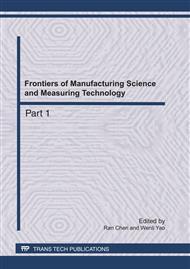p.1063
p.1067
p.1072
p.1079
p.1084
p.1089
p.1093
p.1099
p.1104
Properties of Light Metal Joint Welded by Thermal Compensation Resistance Spot Welding
Abstract:
A new technique of thermal compensation resistance spot welding was used to weld light metal such as aluminum alloy sheet and magnesium alloy. The effects of welding parameters on the tensile shear strength of joint and nugget diameter were investigated. The tensile shear load and nugget of the joint increased with the increasing of welding time, whereas that of the joint decreased with the increasing of electrode force. The joint with the maximum tensile shear load of approximately 5 kN was obtained at the condition of 12 kA and 11 kA welding current for aluminum alloy and magnesium alloy, respectively. The results reveal that the thermal compensation resistance spot welding is a feasible method to weld aluminum alloy and magnesium alloy..
Info:
Periodical:
Pages:
1084-1088
Citation:
Online since:
May 2011
Authors:
Price:
Сopyright:
© 2011 Trans Tech Publications Ltd. All Rights Reserved
Share:
Citation:


